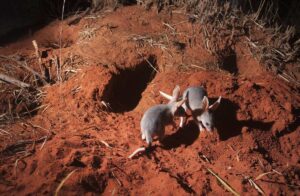Australia’s largest off-grid renewable energy generator is now operational, as lithium miner Liontown Resources flicks the switch on its 95 megawatt (MW) Kathleen Valley remote micro-grid.
The project combines a 16MW solar farm, a 17MW/19 MWh battery and ultimately 30 MW of wind capacity. The first three of the five 6MW Goldwind wind turbines have been commissioned – the other two are built and awaiting commissioning.
Liontown says the project is already powering the on-site accommodation and process plant, and will eventually also power the undergrund lithium mine, and it expects to beat its initial target of meeting 60 per cent of its supply needs for renewables. .
There is some 5MW of diesel standby and 27MW of gas generation that were brought online earlier this year, but these will often be switched off and will operate only when the renewable resources are unavailable.
The solar power component, handled by Australian company 5B, was finished in early November last year and two weeks later the first 81 metre long blade left the Western Australia port of Geraldton for the 700km trip to the Kathleen Valley mine.
Remote mines switch on renewables
Zenith Energy won the Kathleen contract in 2022 to supply electricity to the site on a “build, own and operate basis” over 15 years. The size of the project beats EDL’s 56MW Agnew gold mine project that launched in 2021 with a then unique blend of wind, solar and battery storage.
But although Liontown wins the prize for the largest project, it’s 60 per cent renewables goal will be comprehensively beaten by another Zenith project, the Bellevue Gold mine in Western Australia.
That mine will be powered by 80 per cent renewables from a 26MW solar farm — again supplied 5B and built by RJE Global — that will form a key part of the 89.7MW power plant that will create what is being touted as the first “green gold” production in the world.
The size of the solar component of this project has increased. The original plan was for 24MW of wind, 19MW of solar, 15MW/33MWh of battery storage, and 30MW of gas and diesel backup.
Miners have been leaning into off-grid renewables for years as the cost savings on diesel make wind and solar energy an obvious choice, and and as specialist off-grid operators such as Zenith provide the goods.
Liontown hasn’t said how much it expects to save on fossil fuel costs, but a small New South Wales titanium mine offers an indication of the scale of savings to be had.
In May, Tronox ordered a 11MW solar farm, a 3MW/6MWh battery energy storage system, and a 12MW diesel generator for its Atlas–Campaspe mineral sands mine at Hatfield, near the Mungo National Park. Reducing the number of diesel generators from the current 41 to just six will save about 5 million litres of diesel a year, the company estimates.
Leaning into national battery goals
Earlier this year Liontown secured $550 million investment for the Kathleen Valley mine, one of the world’s largest and highest grade hard rock lithium deposits, to help it to first production this year and ramp that up to an initial 3 million tonnes a year (Mtpa).
The debt financing deal includes the government-owned Clean Energy Finance Corporation (CEFC), which committed $110 million, Australia’s export credit agency Export Finance Australia with $120 million, and commercial lenders the Commonwealth Bank of Australia, National Australia Bank, and Societe Generale.
The Kathleen mine is expected to produce about 500,000 tonnes of six per cent lithium oxide concentrate per year.
Battery metal mines like Kathleen are at the forefront of the federal government’s National Battery Strategy, which was unveiled last month. A key plank is to keep critical minerals such as lithium in the country for longer, to be processed and turned into batteries in the country rather than being shipped overseas.
This part of the plan is the focus of the Battery Breakthrough Initiative, which will offer production-linked incentives for local manufacturers to develop battery making capabilities.










